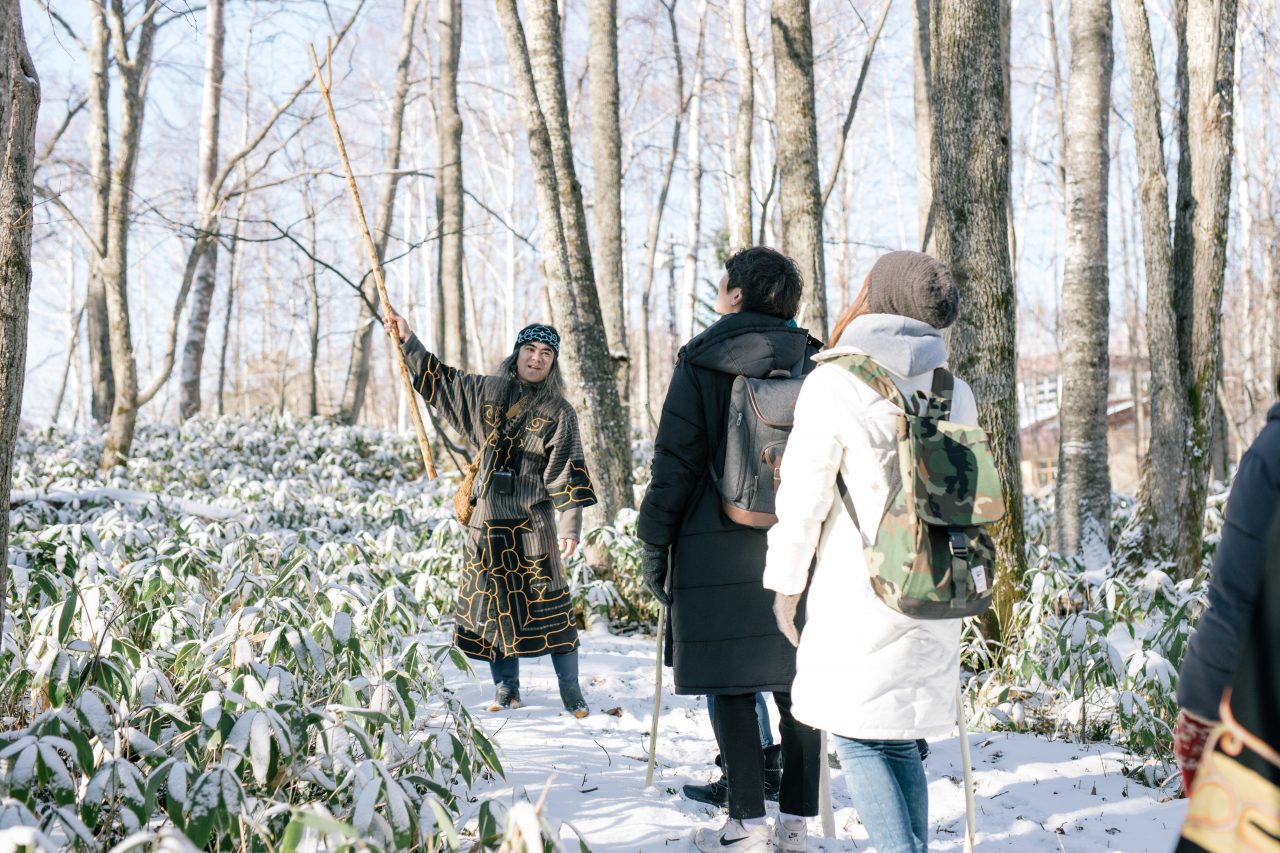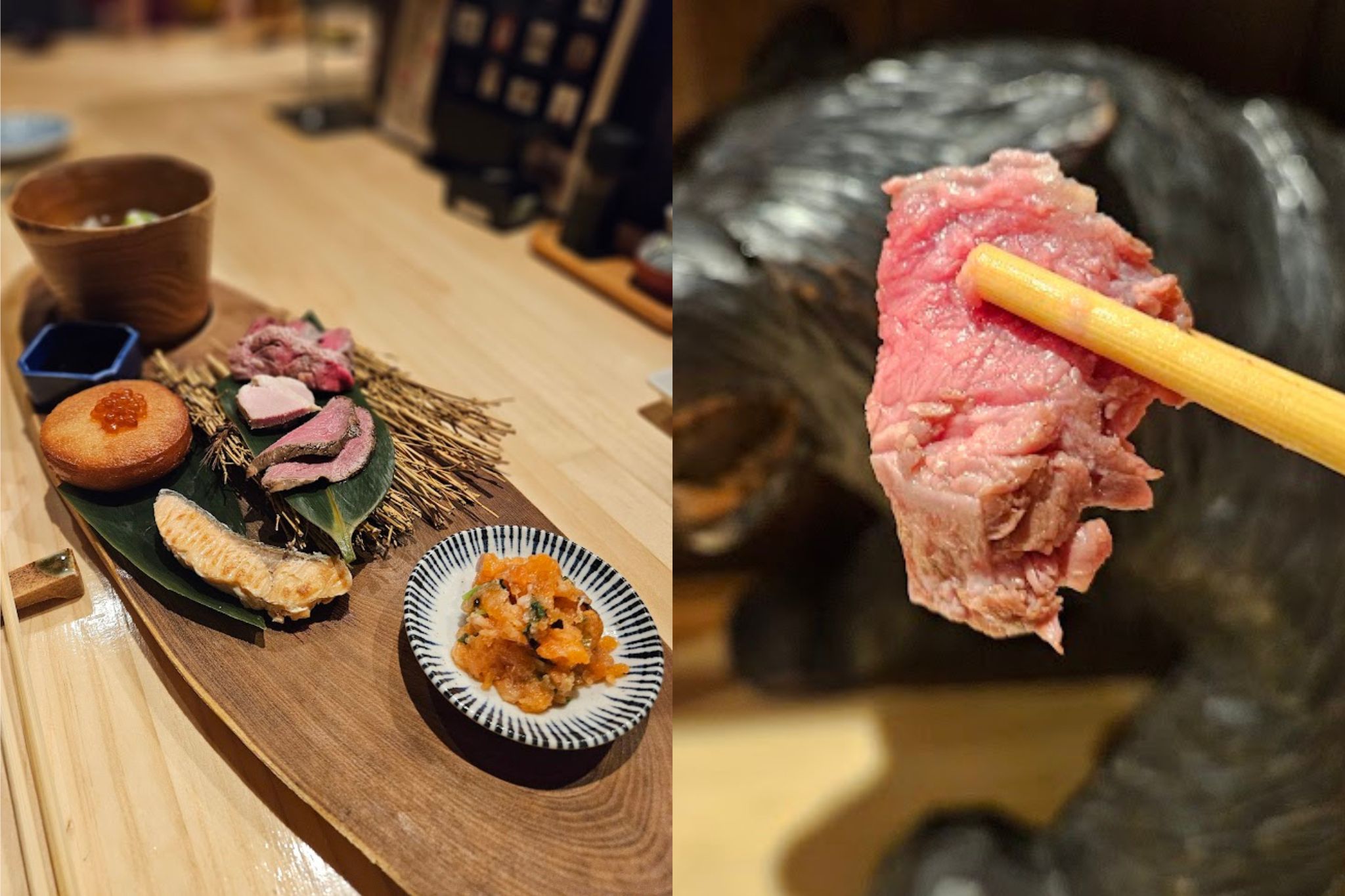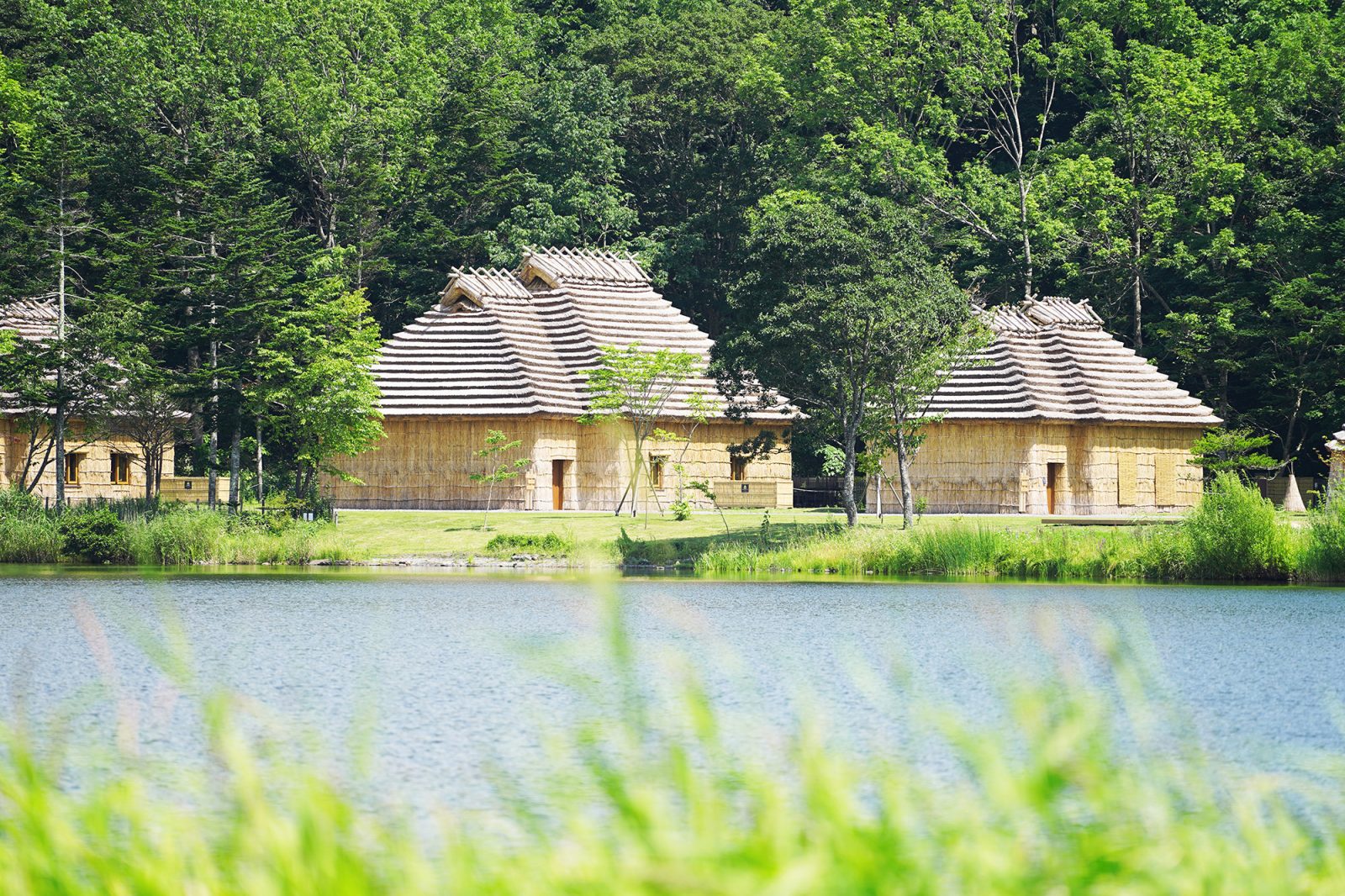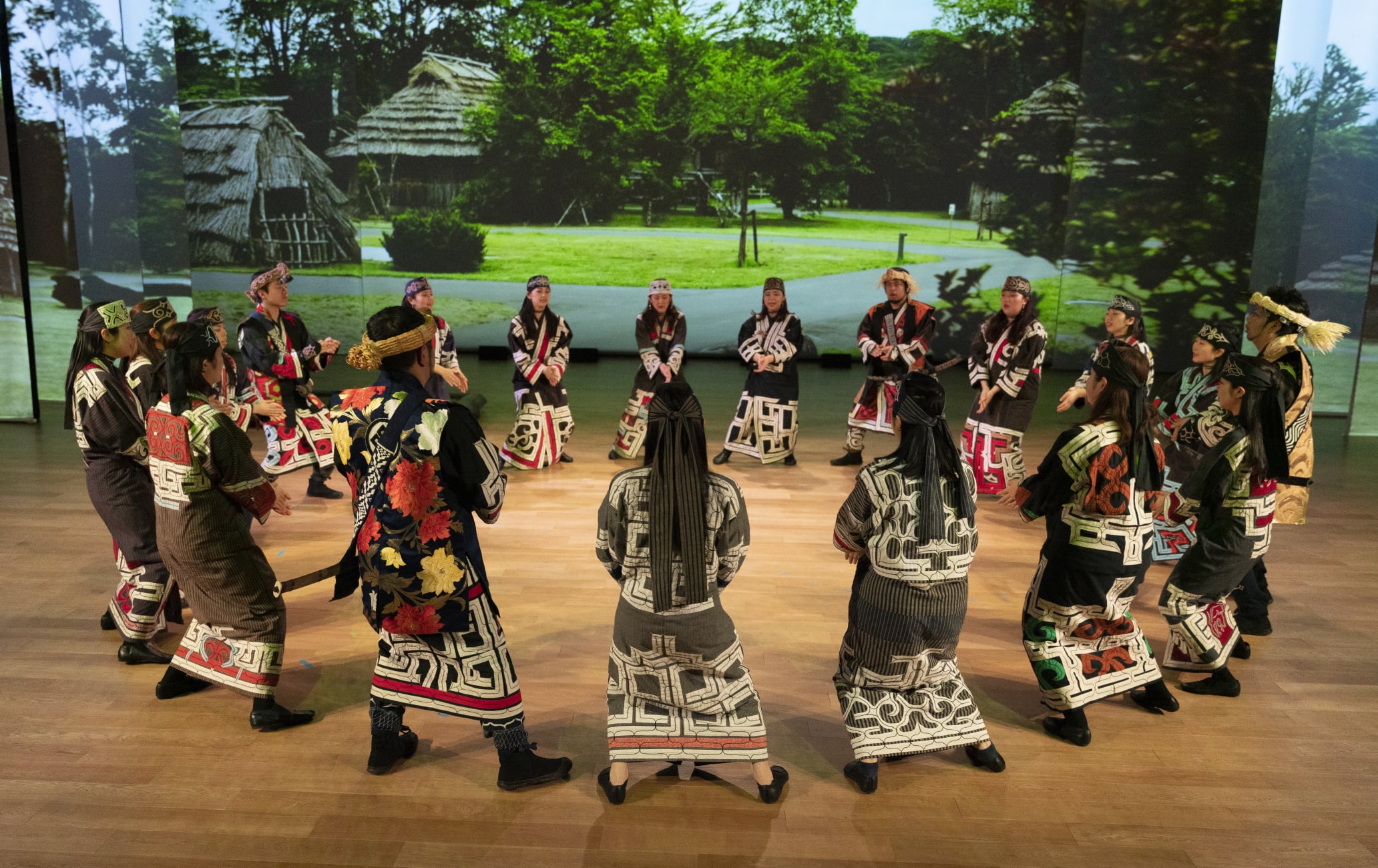NORTH STARS:
Heritage Value
Diversity and Inclusion
Community Support
“From sites like the Kawamura Kaneto Aynu Memorial Museum to guided nature tours, Hokkaido-bound travelers have ample ways to learn about Ainu culture and history.”
From Canada to New Zealand, Indigenous tourism is a growing part of travel across the world. Allowing travelers to connect with Native cultures through workshops, museums, activities, and stays, Indigenous-led tourism initiatives can bring myriad benefits, from helping communities by providing jobs and income to raising awareness about historical injustices, educating others, and aiding in cultural exchange.
On the island of Hokkaido on Japan’s northern tip, one Indigenous group is using the power of tourism to show travelers a different side of this uber-popular Asian destination.

Learning about the Ainu and their connection with nature on an Anytime, Ainutime! tour. Courtesy of Anytime, Ainutime!
Getting to Know the Ainu
On the international stage, travelers know Japan for things like its state-of-the-art cities, ornate temples, and foods like sushi and ramen. But few may even know that Japan has Indigenous ethnic groups; to the south, the Okinawans (also known as the Ryukyuans), and up north, the Ainu. As is the case with Indigenous peoples across the world, the history of the Ainu has been largely swept under the rug, covered up by colonization, assimilation, and discrimination.
Historically native to the lands now part of northern Japan and southeastern Russia, today Hokkaido is the main home of the Ainu. While some smaller populations still reside in Russian territories, the vast majority — an estimated 11,450 individuals according to a 2023 census — call Hokkaido home. This makes the island, best known around Japan for its skiing, ramen, and fresh, local cuisine, one of the best places to learn about and connect with the Ainu way of life.
Believing that spirits and deities, called kamuy, inhabit all natural things, the Ainu hold a deep reverence for nature and lived in tune with it through hunting, gathering, and rituals. Corralled onto Hokkaido by the encroaching Japanese, colonizers started taking over Ainu land and forcing the group to assimilate in the 18th-century Meiji Period. Through laws like the 1899 Hokkaido Former Aborigines Protection Act, the Ainu were denied the right to practice their traditions, language, and lifestyle. This continued throughout much of the 1900s, with ongoing subjugation, discrimination, and negative stereotypes leading to low standards of living for the Ainu, from income to education.
But gradually, Japan is taking steps to atone for past treatment, from officially recognizing the Ainu as an Indigenous people in 2008 to expanding information about the Ainu in Japanese school curriculums.
“Descriptions of the Ainu have been expanded in [Japanese] textbooks, increasing opportunities for learning about the Ainu,” says Tomoko Okawa from the PR division for Upopoy, a Hokkaido-based cultural center dedicated to education and awareness about the Ainu. “Against this background, interest in learning about the Ainu seems to have increased in recent years. Since its opening (July 2020), Upopoy has been used as a destination for educational tours not only in Hokkaido but also from all over Japan.”
These and other actions have helped pave the way for the Ainu to come out of the shadows — and find new ways of sharing their world with others.

Trying traditional Ainu dishes like bear at Umizora no Haru. Courtesy of Zoe Baillargeon.
How to Experience Ainu Culture in Hokkaido, Japan
From sites like the Kawamura Kaneto Aynu Memorial Museum to guided nature tours, Hokkaido-bound travelers have ample ways to learn about Ainu culture and history, from the sorrows of the past to the more hopeful present. Before traveling, it’s also a good idea to familiarize yourself with how to be a respectful visitor when engaging with Indigenous communities, like asking permission before taking photos, leaving sacred sites and spaces alone, and being sensitive and mindful of cultural differences.
Arriving in Sapporo, the island capital which serves as a great base camp with hotels, restaurants, and access to transit, travelers can start their Ainu experience with a meal at Umizora no Haru. Tucked away inside a nondescript building, this tiny izakaya specializes in traditional Ainu cuisine. Either at the wood counter in the art-filled communal dining room or in private rooms fashioned after “chise” houses with reed walls and woven textiles, diners taste a variety of Ainu dishes in curated tasting menus. Starting with glasses of cloudy kamuy tonoto — a ceremonial sake whose name means “God’s Alcohol” — meals include different preparations of salmon, venison, potato mochi, and ohaw soup. Diners also have the rare opportunity to try bear, which is a traditional part of Ainu cuisine and can be served as slices or seasonally in hot pots.
Heading an hour south to the town of Shiraoi, visitors will find one of Hokkaido’s most important Ainu institutions where Okawa says visitors can “understand and restore Ainu culture”: the Upopoy National Ainu Museum and Park. Located on the shores of Lake Poroto, Upopoy is a large cultural center that’s home to the National Ainu Museum and an open-air park with a recreated Ainu village, craft studios, and restaurants. Starting in the National Ainu Museum, visitors can tour permanent exhibits, view educational films, and try interactive exhibits. Elsewhere on the grounds, it’s possible to watch music and dance performances at the Cultural Exchange Hall, tour the traditional village, view and participate in craft workshops like woodworking and weaving, and eat wood-fired Ainu cuisine like Ezo deer at the Haru Ran Na Restaurant. Despite opening in July 2020 during the COVID-19 pandemic, Okawa says that visitor numbers have increased and exceeded 300,000 per year.

A traditional Ainu village at Upopoy. Courtesy of Upopoy.
Ainu Experiences Outside of Sapporo
On the eastern side of the island, the mountainous area now known as Akan Mashu National Park — which boasts rugged landscapes of thick forests, volcanic hot springs, and lakes — is another place of great importance to the Ainu. Here, visitors can bathe in onsen hot springs just as the Ainu have done for thousands of years and try to commune with the region’s kamuy — natural spirits — on hikes. Located on the shores of Lake Akan, the Ainu Kotan village is one of the biggest Ainu settlements on the island, with a theater for dance and stage performances, a cultural museum, traditional buildings, galleries, eateries, and shops featuring work by Ainu artisans. Visitors can also explore the surrounding woods and lakes on guided tours with Anytime, Ainutime!, an Ainu-led tour agency offering outdoor and cultural tours to experience nature through the eyes of the Ainu.
As it’s a four-drive back to Sapporo from Lake Akan, it’s best to overnight in the area. Drive up the Shiretoko Peninsula to stay at the Shucho-no-ie’ Hot Spring Inn, an Ainu-run hotel. Dine on both Ainu and Hokkaidian cuisine in the restaurant, shop for Indigenous handicrafts, and take a soak in the hotel’s natural hot springs onsen.

Zoe Baillargeon is an award-winning travel writer and journalist, writing about travel, food and drink, wine, wellness, culture, nature, and lifestyle for outlets like National Geographic, Travel + Leisure, Conde Nast Traveler, Wine Enthusiast, Bon Appetit, Food & Wine, and many more. Her love for adventure and trying new things has taken her all over the world from dogsledding across northern Sweden to hiking the coast of Japan to wine harvests in Oregon, with stints living in Chile where she fell in love with wine. Currently based in the Pacific Northwest, you can follow her adventures on IG at @zoebaillargeon.



